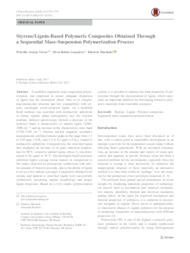Styrene/Lignin-Based polymeric composites obtained through a sequential Mass-Suspension polymerization process.
Styrene/Lignin-Based polymeric composites obtained through a sequential Mass-Suspension polymerization process.
Author(s): VICTOR, P. A.; GONCALVES, S. B.; MACHADO, F.
Summary: A modified sequential mass-suspension polymerization was employed to ensure adequate dispersion of lignin into the monomeric phase. Due to its complex macromolecular structure and low compatibility with styrene, eucalyptus wood-extracted lignin, via a modified Kraft method, was esterified with methacrylic anhydride to ensure organic phase homogeneity into the reaction medium. Infrared spectroscopy showed a decrease in the hydroxyl band, a characteristic of natural lignin (3200?3400 cm−1) and an increase in the characteristic ester band (1720?1740 cm−1) whereas nuclear magnetic resonance measurements exhibited intense peaks in the range from 1.7 to 2.05 ppm (?CH3) and 5.4 to 6.2 ppm (=CH2), related to methacrylic anhydride. Comparatively, the esterified lignin also displayed an increase of its glass transition temperature for 98 °C, related to natural lignin, whose Tg was determined to be equal to 91 °C. Styrene/lignin-based polymers exhibited higher average molar masses in comparison to the values observed for polystyrene synthesized with similar amounts of benzoyl peroxide, due to the ability of lignin to act as a free-radical scavenger. Composites obtained with styrene and natural or esterified lignin were successfully synthesized, presenting regular morphology and proper lignin dispersion. Based on a very simple polymerization system, it is possible to enhance the final properties of polystyrene through the incorporation of lignin, which represents an important platform for developing attractive polymeric materials from renewable resources.
Publication year: 2018
Types of publication: Journal article
Unit: Embrapa Agroenergy
Observation
Some of Embrapa's publications are published as ePub files. To read them, use or download one of the following free software options to your computer or mobile device. Android: Google Play Books; IOS: iBooks; Windows and Linux: Calibre.
Access other publications
Access the Agricultural Research Database (BDPA) to consult Embrapa's full library collection and records.
Visit Embrapa Bookstore to purchase books and other publications sold by Embrapa.

